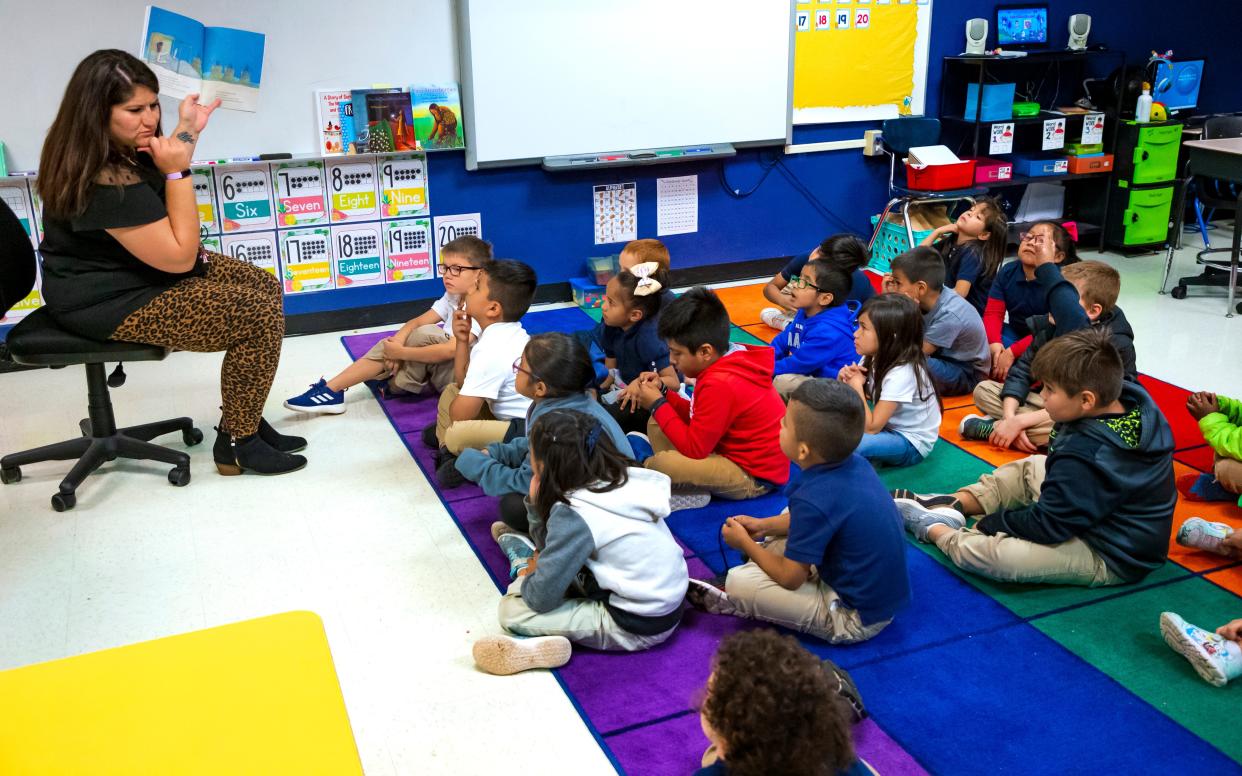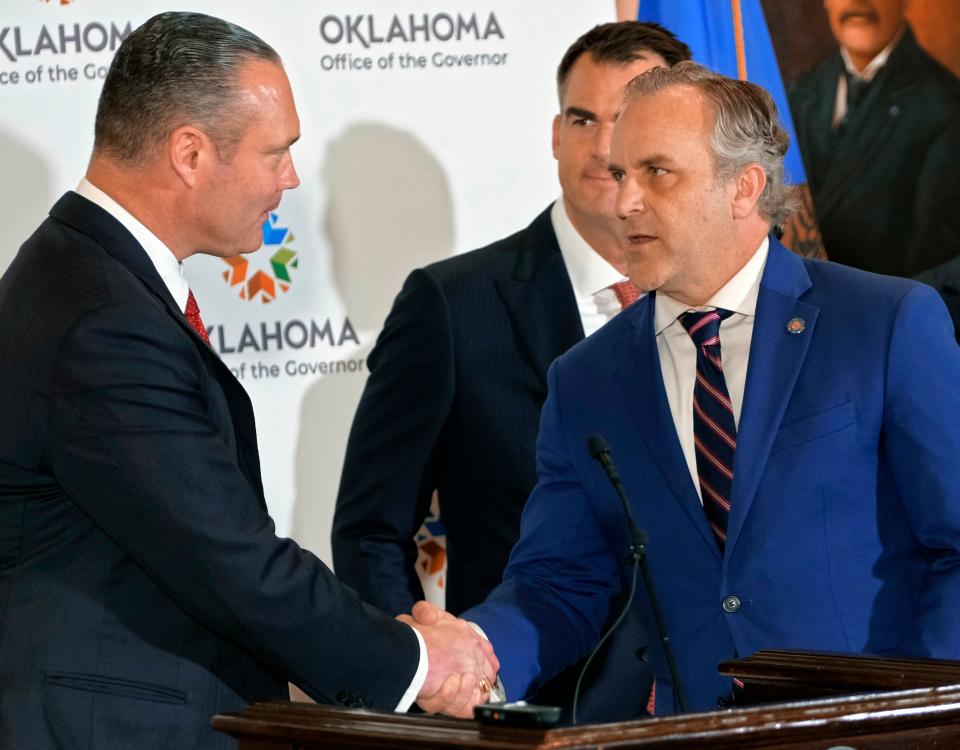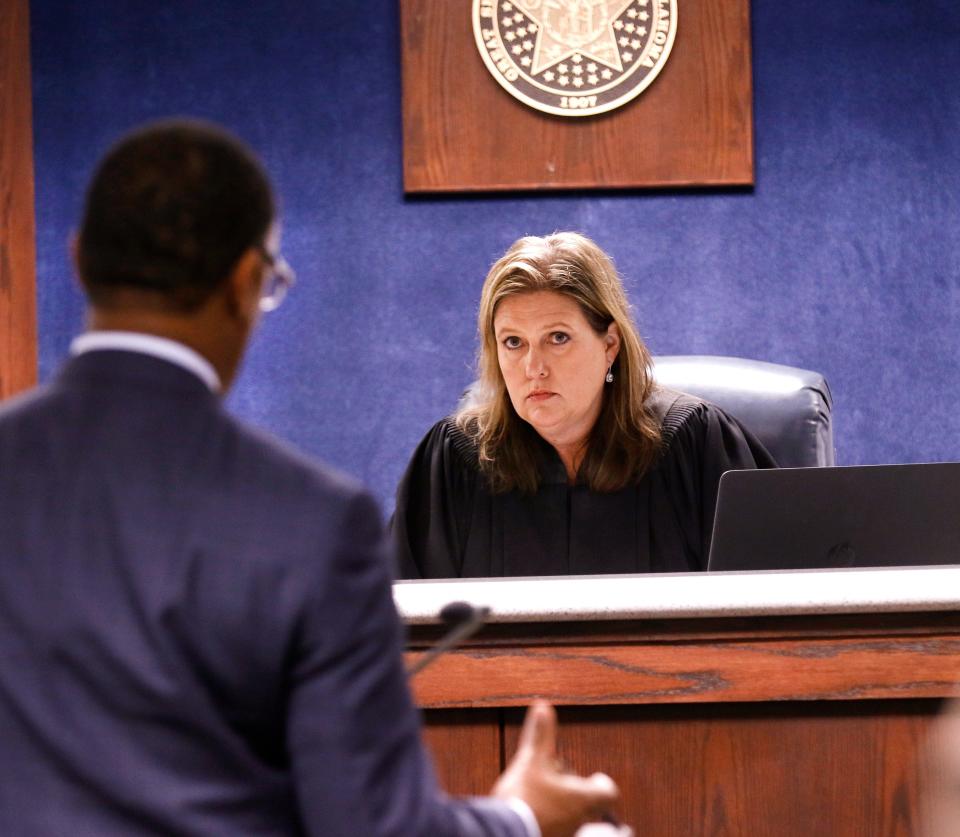Funding for teachers, crucial state services have been buried by the tax cut debate

- Oops!Something went wrong.Please try again later.
- Oops!Something went wrong.Please try again later.
- Oops!Something went wrong.Please try again later.
The call for reducing Oklahoma's tax rates has a long and storied history.
In addition to the efforts of Gov. Kevin Stitt, the three governors who held office before him also pushed for tax cuts. During the tenure of Gov. Mary Fallin, the state's personal income-tax rate was reduced twice. And before that, governors Brad Henry, a Democrat, and Frank Keating, a Republican, passed their own tax-cut proposals.
Four governors; four rounds of tax cuts.
But history shows tax cuts can backfire.
That was the case for Fallin. During her time in office, the tax cuts endorsed by Fallin contributed to a warning in 2016 that the state was facing an $868 million budget deficit because "sustained low oil prices, tax cuts and corporate tax credits continue to weigh on the state's finances."
And once cut, taxes are almost impossible to increase in Oklahoma since the passage State Question 640 in 1992. The measure changed the state Constitution to require a three-fourths majority in each legislative chamber, or a public vote, to increase taxes.
Still, while the debate over tax cuts rages, little attention has been given to proposals to fund the upkeep of state highways, bridges and buildings. As detailed in a story by The Oklahoman, the cost of catching up to all the deferred maintenance in these areas has grown so big it is now estimated to be many billions of dollars.
That's billions with a "B."
More: As Gov. Stitt focuses on tax cuts, Oklahoma faces $25 billion in overdue infrastructure repairs
Some state political leaders recognize this. Senate President Pro Tempore Greg Treat this week acknowledged the backlog of deferred maintenance and infrastructure projects during a news conference at the Capitol.
Treat, asked if the state had enough money to address the backlog, was direct: "Not to the extent that I saw that your publication ran today," he said. "We don't. We have a substantial amount we can invest, around a billion dollars or so, but not to the totality of all those unmet needs."
Deferred maintenance and infrastructure aren't the state's only needs: Lawmakers will have to address cost of improving education, an area where the state gets low rankings, and the cost of maintaining the third branch of state government, the judicial system, which currently is forced to sustain largely with fines and fees.
Like tax cuts, those issues generate both phone calls and headaches.

When Keating was elected governor in the fall 1994, the income tax rate at 6.75% was two percentage points higher than it is today. At the same time, Oklahoma’s average teacher pay was $28,745, fifth-lowest in the nation. By the time the teachers went on strike in 2018, their pay was third-lowest.
This was after a huge effort just four years before to pump millions of extra dollars into the common education system and dramatically change education policy. That effort, led in part by Republican Gov. Henry Bellmon, was known by the bill number: House Bill 1017, and — for a brief moment — was a game-changer.
But just a few years after HB 1017 became law, things began to revert. By the time Keating became governor, there was another grueling debate over raising taxes and education funding. After the struggle, the teachers eventually received a $6,000 annual pay raise.
More: State revenue estimates good, but not good enough for two tax cuts, Senate leader says
As a result, average teacher pay in Oklahoma rose from 48th to 34th.
Fast forward to today.
Oklahoma has a shortage of teachers — with a record-high 4,797 certified for emergency duty for the 2023-24 school year — and the state ranks only 38th in teacher pay.
And yet the talk about tax cuts continues.
Even the voting public has questions. Last October, a poll by Amber Integrated of Oklahoma City underscored the public's concerns over basic services, tax cuts and education.
According to the poll, 54% of those surveyed were concerned that a tax cut might lead to reductions in state services if the economy takes a downturn. The same poll reported 64% were dissatisfied with the quality of education being provided to students in their communities, and 38% were very unsatisfied.
This year, Sen. Adam Pugh, R-Edmond, proposed a $1,500 to $3,000 pay boost for certified public-school employees, most of whom are teachers. House education budget subcommittee Chairman Mark McBride, R-Moore, said he was developing a new teacher bonus program that spread the bonuses out over several years.
Oklahoma schoolteachers have, in recent years, received more support than other state workers. The Senate's budget chairman, Sen. Roger Thompson, R-Okemah, is trying to change that. Thompson filed legislation this year that would increase state employee pay by 9%.
But Thompson's bill faces tough sledding. Stitt said that he will not consider a pay raise for state employees until all Oklahomans get a tax cut. And the governor remains steadfast in his call for tax cuts.
“Let’s give taxpayers a pay raise first," the governor said. "After that, we can talk about government employees."

Oklahoma judicial system funding lost in talk of tax cuts
What's being left out of that ongoing conversation on tax cuts, education funding, infrastructure and state employee pay is big — as in third branch big — the state's judicial system.
Oklahoma's judiciary — from district to appellate courts — has remained, financially, the weakest branch of state government. As a result, the courts have been forced to supplement their funding through fines and fees, which continue to increase.
Though many lawmakers have expressed concerns over infrastructure, maintenance and agency funding, the effort to cut taxes has overshadowed agency funding discussions, because funding and deferred maintenance on state facilities doesn't generate the attention, or votes, that a call for a tax cut does.
Former Lt. Gov. Jari Askins, now the administrative director of the courts, understands this. Askins told the Tulsa World in 2019 that revenue from designated fees has stagnated or declined.
"Fees raised for a specific purpose aren't supposed to be used for anything else," Askins told the newspaper. "But when you've got a revenue failure and the Legislature says use it, you use it to not lay people off."
Askins said her first goal was to "wean the state off executive branch fees by increasing appropriations to those agencies in the next few years."
"Oklahoma's Supreme Court Justices are concerned that we have reached the limit of being able to ask any more of our judges and just cannot in good conscience go any farther in trying to do more with the court system run primarily on collections of fines and costs," she said.
An analysis of the judiciary's funding levels shows that between 75% and 85% of the annual funding for the state's district courts comes from fines and fees, with the remainder appropriated by state lawmakers. Oklahoma's district attorneys are forced to generate about 55% of their own budgets.
Records show the state's district courts were appropriated about $86.9 million for FY 2024, while the Court of Criminal Appeals received $4.1 million and the Oklahoma Supreme Court $17 million.
Compare that to the funding for the state's other two branches of government: In FY 2024, the Oklahoma House of Representatives received $22,786,198. The Oklahoma Senate had an appropriation of $12,780,075, and the Legislative Service Bureau — an agency that provides support for both the House and Senate — received $30,557,008 for a total of more than $66.1 million. During that same fiscal year. Stitt's office received $2,557,940 and the lieutenant governor, $714,665, close for $4 million total. In addition, the Office of Management and Enterprise Services — an agency that is heavily influenced by both the state's chief executive and legislative leaders — received $145,855,616.
Debate over tax cuts overshadows calls for agency funding
For two years now, Stitt's push for a tax cut has drawn real traction in the House of Representatives. There, House Speaker Charles McCall, R-Atoka, has said a tax cut is necessary because it's the only mechanism the state has to help residents combat inflation.
McCall has said little about the state's deferred maintenance and infrastructure needs. He and Stitt have said they don't want to "grow" state government. McCall said there was more than one way of looking at the tax cut versus spending on infrastructure debate.
"We can’t print money. We don’t set monetary policy at the state level," McCall said. "They (Oklahomans) need more money to address just the basic budgets. If we want to be responsive to them, we’ve got to find a way to do that. The tax cut is not the only thing that’s been discussed. I do think it is the best mechanism for us in the short run and in the long run."
More: Why Democrats think Gov. Kevin Stitt is 'out of touch' with everyday Oklahomans
Cutting the tax rate, the speaker said, doesn't make the money go away. The money is going to stay with the people that normally pay it into the state, McCall said.
"That $250 million, it goes to somebody else, who spends it again, who spends it again, who spends it again," McCall said last week. "The last time we cut taxes in the state ... our revenues are half a billion dollars higher today than they were at that time. I believe that’s the economic impact of the tax cut."
How well have Oklahoma tax cuts worked in the past?
Shiloh Kantz, an analyst at the Oklahoma Policy Institute, a statewide think tank, isn't so sure about McCall's theory. She said Oklahoma's stint as a "laboratory for tax cuts" hasn't worked as well as many lawmakers claimed.
"Oklahoma lawmakers have cut the state’s personal income tax rates nine times in the last 20 years," Kantz said. "When adjusted for inflation and population growth, the current state budget this year is 12% smaller than it was two decades ago."
Cutting the personal income tax overpromises and underdelivers for everyday Oklahomans who need it the most, she said.
Treat, the Senate leader, and a Republican like Stitt and McCall, has been cautious in suggesting that both tax cuts might be possible. While Treat is on record supporting a cut in the state's grocery tax, he said Oklahoma can't afford to cut both the grocery tax and reduce the personal income tax.
And the question remains, can Oklahoma afford to cut taxes and, at the same time, boost the amount of spending on critical state agencies and infrastructure needs?
The state's Board of Equalization issued a report Thursday certifying the state would have more than $11 billion to spend in the next fiscal year. Even with that increase, Treat said there was only enough money for one cut.
“These numbers are certainly encouraging, and they show a lot of promise,” Treat said. “With these numbers and the current savings we have, now is the time to cut the grocery tax. Cutting the grocery tax will give Oklahomans immediate relief every time they leave the grocery store and will be more beneficial than any other form of tax cut."
Stitt, however, said there was room for both. But he added that "fiscal conservatism" would still be needed, which seemed to indicate that he would support spending on deferred maintenance and infrastructure.
"Our economy is just super strong. Oklahomans are resilient. Our business community is great. Unemployment is low. We've got a huge energy advantage here," the governor said. "Oklahoma's the place to be and companies are realizing that all over the country and fortunately we've got, you know, continued revenue increase and that's a good thing, and that's why I do think that we need to be very cautious and we can't just keep spending. We need to give tax cuts back to the taxpayer."
Kantz, the Oklahoma Policy Institute analyst, said if Oklahoma moves forward with Stitt's proposal to gradually eliminate the state income tax completely, "Oklahoma will have eliminated one of every three dollars from last year’s general revenue fund."
Eliminating the personal income tax, she said, "will drastically worsen the inequality in our tax code. Without the personal income tax, the lowest income Oklahoma taxpayers will pay a state and local tax rate 300% higher than the top 1%."
"When you run the numbers, it’s evident that the math is not mathing," she said. "Look at the impact of a quarter of a percent cut to personal income tax. The lowest-income Oklahomans will get back $19 a year, which likely isn’t even a tank of gas. Middle-income Oklahomans will get $92 a year back, possibly enough to pay their gas bill. The richest 1% of Oklahomans, however, would receive $2,600 — enough to buy a round-trip ticket to Europe."
This article originally appeared on Oklahoman: Conflict over Oklahoma tax cuts vs. other deferred spending needs

